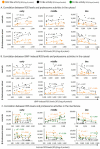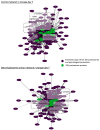Red Blood Cell Proteasome in Beta-Thalassemia Trait: Topology of Activity and Networking in Blood Bank Conditions
- PMID: 34564533
- PMCID: PMC8466122
- DOI: 10.3390/membranes11090716
Red Blood Cell Proteasome in Beta-Thalassemia Trait: Topology of Activity and Networking in Blood Bank Conditions
Abstract
Proteasomes are multi-catalytic complexes with important roles in protein control. Their activity in stored red blood cells (RBCs) is affected by both storage time and the donor's characteristics. However, apart from their abundancy in the membrane proteome, not much is known about their topology, activity, and networking during the storage of RBCs from beta-thalassemia trait donors (βThal+). For this purpose, RBC units from fourteen βThal+ donors were fractionated and studied for proteasome activity distribution and interactome through fluorometric and correlation analyses against units of sex- and aged-matched controls. In all the samples examined, we observed a time-dependent translocation and/or activation of the proteasome in the membrane and a tight connection of activity with the oxidative burden of cells. Proteasomes were more active in the βThal+ membranes and supernatants, while the early storage networking of 20S core particles and activities showed a higher degree of connectivity with chaperones, calpains, and peroxiredoxins, which were nonetheless present in all interactomes. Moreover, the βThal+ interactomes were specially enriched in kinases, metabolic enzymes, and proteins differentially expressed in βThal+ membrane, including arginase-1, piezo-1, and phospholipid scramblase. Overall, it seems that βThal+ erythrocytes maintain a considerable "proteo-vigilance" during storage, which is closely connected to their distinct antioxidant dynamics and membrane protein profile.
Keywords: activity; beta thalassemia trait; interactome; membrane localization; proteasome; proteostasis; red blood cell; regulation; storage.
Conflict of interest statement
Though unrelated to the contents of this manuscript, A.D. declares that he is a founder of Omix Technologies Inc and Altis Bioscience LLC and a consultant for Hemanext Inc. All other authors declare no conflict of interest.
Figures







Similar articles
-
The Post-Storage Performance of RBCs from Beta-Thalassemia Trait Donors Is Related to Their Storability Profile.Int J Mol Sci. 2021 Nov 13;22(22):12281. doi: 10.3390/ijms222212281. Int J Mol Sci. 2021. PMID: 34830162 Free PMC article.
-
Proteome of Stored RBC Membrane and Vesicles from Heterozygous Beta Thalassemia Donors.Int J Mol Sci. 2021 Mar 25;22(7):3369. doi: 10.3390/ijms22073369. Int J Mol Sci. 2021. PMID: 33806028 Free PMC article.
-
Red cell proteasome modulation by storage, redox metabolism and transfusion.Blood Transfus. 2022 Jan;20(1):27-39. doi: 10.2450/2020.0179-20. Epub 2020 Nov 27. Blood Transfus. 2022. PMID: 33263521 Free PMC article.
-
Chronological storage age and metabolic age of stored red blood cells: are they the same?Transfusion. 2019 May;59(5):1620-1623. doi: 10.1111/trf.15248. Epub 2019 Mar 13. Transfusion. 2019. PMID: 30865302 Review.
-
Structural Insights into Substrate Recognition and Processing by the 20S Proteasome.Biomolecules. 2021 Jan 24;11(2):148. doi: 10.3390/biom11020148. Biomolecules. 2021. PMID: 33498876 Free PMC article. Review.
Cited by
-
Cellular and biochemical heterogeneity contributes to the phenotypic diversity of transfusion-dependent β-thalassemia.Blood Adv. 2025 May 13;9(9):2091-2107. doi: 10.1182/bloodadvances.2024015232. Blood Adv. 2025. PMID: 39928952 Free PMC article.
-
The Post-Storage Performance of RBCs from Beta-Thalassemia Trait Donors Is Related to Their Storability Profile.Int J Mol Sci. 2021 Nov 13;22(22):12281. doi: 10.3390/ijms222212281. Int J Mol Sci. 2021. PMID: 34830162 Free PMC article.
-
Innate Variability in Physiological and Omics Aspects of the Beta Thalassemia Trait-Specific Donor Variation Effects.Front Physiol. 2022 Jun 8;13:907444. doi: 10.3389/fphys.2022.907444. eCollection 2022. Front Physiol. 2022. PMID: 35755442 Free PMC article.
-
Molecular modifications to mitigate oxidative stress and improve red blood cell storability.Front Physiol. 2024 Oct 30;15:1499308. doi: 10.3389/fphys.2024.1499308. eCollection 2024. Front Physiol. 2024. PMID: 39539958 Free PMC article. Review.
-
Proteostasis and metabolic dysfunction characterize a subset of storage-induced senescent erythrocytes targeted for posttransfusion clearance.J Clin Invest. 2025 Mar 11;135(9):e183099. doi: 10.1172/JCI183099. eCollection 2025 May 1. J Clin Invest. 2025. PMID: 40067362 Free PMC article.
References
Grants and funding
LinkOut - more resources
Full Text Sources
Research Materials

